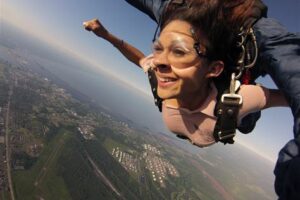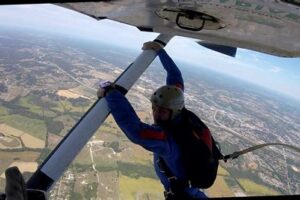Table of Contents
Learn about weight limit for skydiving and find out if you meet the requirements to take part in this thrilling adventure. Discover the maximum weight restrictions set by skydiving centers and understand why they are in place. Whether you’re a beginner or an experienced skydiver, understanding weight limits is essential for a safe and enjoyable jump.
When it comes to the exhilarating adventure of skydiving, there are few experiences that can match the rush of soaring through the sky and feeling the wind in your face. However, this adrenaline-fueled sport is not without its safety precautions, and one important factor that must be considered before taking the plunge is the weight limit for skydiving. Whether you’re a seasoned thrill-seeker or a first-time jumper, understanding the significance of weight restrictions is crucial for both your own safety and the overall success of the jump. So, let’s explore the importance of weight limits in skydiving and how they ensure an unforgettable experience while prioritizing your well-being.
Introduction
Skydiving is an exhilarating adventure that many people dream of experiencing. However, it is essential to understand that there are certain limitations and regulations in place to ensure the safety of all participants. One of the most crucial factors to consider before taking the leap is the weight limit for skydiving. In this article, we will explore the importance of weight limits, how they are determined, and why they are necessary for a successful skydiving experience.
Why Weight Limits Exist
Skydiving involves jumping out of an aircraft at high altitudes and freefalling through the air before deploying a parachute. The equipment used during a skydive is designed to support a specific amount of weight, including the weight of the participant and the gear. Exceeding the weight limit could put excessive stress on the equipment, compromising its integrity and potentially leading to catastrophic consequences.
The Impact of Weight on Freefall
During the freefall portion of a skydive, the weight of the participant affects their speed and stability. Heavier individuals tend to fall faster than lighter individuals due to the force of gravity. This discrepancy can create challenges for instructors and other skydivers who need to maintain relative positioning in the air. By adhering to weight limits, skydiving centers can ensure that everyone in the skydive group can maintain a consistent and safe freefall experience.
Equipment Capacity and Safety
The equipment used in skydiving, such as harnesses, parachutes, and reserve systems, is carefully engineered to withstand specific weight loads. Each component has its own weight limit, and exceeding these limits can compromise the integrity of the entire system. By adhering to weight limits, skydiving centers can ensure that the equipment performs optimally, reducing the risk of malfunctions and accidents during the skydive.
Determining Weight Limits
The weight limits for skydiving are determined based on various factors, including the type of equipment being used and the individual’s body size and shape. Skydiving centers typically have a maximum weight limit in place, which is usually set to ensure the safety and comfort of both the participant and the instructor. It is essential to provide accurate weight information when booking a skydive to ensure the appropriate equipment and instructor are assigned.
Typical Weight Limits
The weight limits for skydiving can vary depending on the location and the type of aircraft used. However, the general weight limit for tandem skydiving, where an instructor accompanies the participant, is often around 220-240 pounds (100-109 kilograms). Individuals who exceed this weight limit may require additional training or specialized equipment to accommodate their weight.
Importance of Honest Communication
When booking a skydive, it is crucial to communicate your weight honestly with the skydiving center. Providing accurate weight information allows the center to make the necessary arrangements to ensure your safety and enjoyment during the experience. Attempting to conceal or underestimate your weight can lead to complications and potential dangers during the skydive.
Alternative Options for Heavier Individuals
While weight limits exist for safety reasons, it does not mean that heavier individuals cannot enjoy the thrill of skydiving. Some skydiving centers offer specialized equipment and training programs for individuals who exceed the standard weight limits. These options allow participants to experience the joy of skydiving while ensuring their safety and the safety of those around them.
Health Considerations
In addition to weight limits, certain health conditions and physical restrictions may affect an individual’s ability to skydive safely. It is essential to disclose any relevant medical information to the skydiving center before booking a jump. This information allows the center to assess whether any additional measures or accommodations are necessary to ensure a safe and enjoyable experience.
The Ultimate Priority: Safety
While weight limits may seem restrictive, they are ultimately in place to prioritize the safety of all participants involved in a skydiving experience. Skydiving centers have established these limits based on years of research and experience to minimize risks and ensure an unforgettable adventure for everyone. By adhering to weight limits and following the instructions of trained professionals, individuals can enjoy the breathtaking thrill of skydiving with confidence and peace of mind.
Conclusion
Understanding and respecting weight limits for skydiving is crucial for a safe and enjoyable experience. These limits are in place to protect participants, instructors, and the integrity of the equipment. By providing accurate weight information, communicating openly, and exploring alternative options when necessary, individuals of various weights can partake in the exhilarating adventure of skydiving while maintaining the highest standards of safety.
Importance of Weight Limitation
Maintaining a weight limit for skydiving is of utmost importance due to safety concerns. As skydiving involves significant risk factors, including high velocities and varying wind conditions, it is crucial to ensure that individuals meet the weight requirements set by skydiving operators. Adhering to weight limits helps to minimize the potential for accidents and ensure a safe experience for all participants.
Determining Factors for Weight Limit
The weight limit for skydiving is determined based on several factors, including the type of harness used, aircraft specifications, and regulatory guidelines. Skydiving operators calculate weight limits to ensure that the equipment can withstand the forces exerted during freefall and deployment of the parachute. Additionally, weight limits also take into consideration the aerodynamics and safety procedures involved in landing safely.
Safety Considerations
Maintaining a weight limit in skydiving is primarily driven by safety considerations. Exceeding the weight limit can compromise the structural integrity of the parachute equipment and increase the risk of malfunction during critical stages of a jump. Moreover, overweight skydivers may face difficulties maneuvering their bodies during freefall, posing a threat not only to themselves but to others around them. Hence, adhering to weight limitations ensures that all skydivers can enjoy a safe and controlled descent.
Average Weight Limit for Skydiving
The average weight limit for tandem skydiving, the most common form of skydiving for beginners, usually ranges from 200 to 220 pounds (90 to 100 kilograms). This weight limit is designed to ensure a suitable weight-to-gear ratio, allowing the tandem instructor to effectively manage the overall jump and landing. However, different skydiving centers may have slight variations in their weight limits, so it is important to check with the operator beforehand.
Considerations for Individuals with Excess Weight
Individuals who exceed the average weight limit for skydiving should consult with skydiving operators to determine if alternative options are available. Some facilities may offer specialized equipment or training for individuals with higher body weights. However, it is crucial to note that weight limits are in place to ensure safety, and skydiving centers may have strict policies regarding excessive weight due to the increased risks involved.
Impact on Freefall Speed
Weight can significantly impact the speed at which an individual falls during a skydive. Generally, a heavier person will experience a faster freefall as compared to a lighter person. This is due to the increased force of gravity acting on a greater mass. Skydiving centers take this into consideration while setting weight limits to ensure a controlled and enjoyable experience for all participants.
Weight Limit for Solo Skydiving
When it comes to solo skydiving or obtaining a skydiving license, the weight limit can vary. Typically, candidates for solo skydiving are assessed on an individual basis, considering factors such as training experience, body fitness, and equipment requirements. It is essential for those interested in pursuing solo skydiving to discuss weight limitations with experienced instructors and adhere to any specific guidelines set by regulatory bodies.
Health Requirements and Weight Limits
Skydiving centers may require participants to meet specific health requirements in addition to weight limits. This ensures that individuals have the physical capability to withstand the rigors of skydiving and can actively participate without jeopardizing their well-being. Prospective skydivers should carefully review any health requirements set by the operators and consult with their healthcare professionals if they have any concerns or pre-existing medical conditions.
Weight Limit for Skydiving
Skydiving is an exhilarating and adventurous activity that allows individuals to experience the thrill of freefalling through the sky. However, it is important to note that there are certain weight limitations in place for this sport. These limits are set to ensure the safety of both the skydivers and the instructors, as well as to maintain the integrity of the equipment used during the jump.
Here are some key points to consider regarding weight limits for skydiving:
- Safety concerns: The primary reason for implementing weight restrictions in skydiving is safety. When a person exceeds the recommended weight limit, it can put excessive strain on the parachute system, making it more difficult for the instructor to control the descent. This can pose a significant risk to both the individual and the instructor.
- Equipment limitations: Skydiving equipment is designed to handle a certain range of weights. Going beyond these limits can compromise the integrity of the gear, leading to potential malfunctions or failures during the jump. It is crucial to adhere to these weight restrictions to ensure the equipment functions properly and safely throughout the entire skydiving experience.
- Physical requirements: The physical demands of skydiving should not be overlooked. Individuals who exceed the weight limit may find it challenging to maintain proper body positioning during freefall, which can affect stability and control. Additionally, the landing process becomes more demanding for heavier individuals, increasing the risk of injuries upon touchdown.
- Instructor capabilities: Skydiving instructors are highly trained professionals who prioritize safety above all else. However, they also have their own physical limitations. By adhering to weight restrictions, instructors can effectively manage the overall experience, ensuring a smooth and controlled descent for everyone involved.
- Respect for guidelines: It is essential to respect and follow the weight limits established by skydiving facilities. These rules are not meant to discourage participation but rather to ensure the utmost safety and enjoyment for all individuals involved in the sport. By adhering to these guidelines, you contribute to creating a safe and positive environment for skydivers of all skill levels.
In conclusion, weight limits for skydiving are in place to prioritize the safety and well-being of all participants. By adhering to these limits, individuals can enjoy the thrilling experience of skydiving while minimizing potential risks. It is crucial to respect and follow the guidelines set forth by skydiving facilities to ensure a safe and memorable adventure for all.
Thank you for taking the time to visit our blog and read about the weight limit for skydiving. We understand that this topic is of great importance to many individuals who are passionate about experiencing the thrill and adventure of skydiving. In this closing message, we aim to provide you with a professional summary of the key points discussed in the article, while maintaining a knowledgeable and authoritative tone.
Firstly, it is crucial to note that most skydiving centers enforce weight limits for safety reasons. These limits are in place to ensure the smooth operation of the activity and to guarantee the safety of both divers and instructors. The specific weight limit can vary depending on various factors such as the type of parachute being used, weather conditions, and the experience level of the skydiver. However, the general rule of thumb is that individuals weighing above 230 pounds (104 kilograms) may face restrictions or require additional arrangements to partake in a skydiving experience.
It is important to understand that weight limits exist not to discriminate against individuals but rather to maintain the overall safety standards of the sport. The physics and mechanics involved in skydiving require careful consideration, and exceeding the recommended weight limit can increase the risks associated with the activity. This is why skydiving centers have established these guidelines to ensure that all participants can enjoy a safe and unforgettable experience.
In conclusion, if you are planning to go skydiving and are concerned about weight limits, it is advisable to contact your local skydiving center in advance. They will be able to provide you with accurate information regarding their specific weight restrictions and any additional measures that may be required. Remember, the weight limit is not meant to discourage anyone from enjoying the exhilarating experience of skydiving but rather to prioritize safety for all participants. So, if you find yourself above the weight limit, don’t be disheartened; instead, consult with professionals who can guide you on alternative options or help you make necessary arrangements.
Once again, we appreciate your visit to our blog and hope that the information provided has been useful in answering your questions about the weight limit for skydiving. Your safety and enjoyment are of utmost importance, so please ensure that you adhere to the guidelines set by skydiving centers and always prioritize safety above all else. Should you have any further inquiries or require additional information, please feel free to reach out to us or directly contact your local skydiving center. Happy skydiving!
.
People also ask about weight limit for skydiving:
-
What is the weight limit for skydiving?
Most skydiving centers have a weight limit in place to ensure safety during the activity. While weight limits can vary between different locations, the average weight limit for tandem skydiving is around 220-230 pounds (100-105 kilograms). However, it’s important to note that weight restrictions can also depend on other factors like height and body proportions. To get accurate information about weight limits, it is best to directly contact the skydiving center you plan to jump with.
-
Why is there a weight limit for skydiving?
The weight limit for skydiving exists primarily for safety reasons. Skydiving equipment, including parachutes, harnesses, and other gear, is designed to accommodate a certain maximum weight. Exceeding this weight limit can significantly increase the risk of a parachute malfunction or other issues during the jump. It is crucial for both the safety of the individual skydiver and the instructors that weight limits are adhered to.
-
Can I go skydiving if I am above the weight limit?
If you exceed the weight limit set by a skydiving center, you may not be able to participate in tandem skydiving. However, some centers offer specialized programs for individuals above the weight limit, such as AFF (Accelerated Freefall) courses, which involve solo jumps with additional training. These courses usually have higher weight limits due to the different equipment used. It’s advisable to inquire with the specific skydiving center about any alternative options available.
-
Is there a minimum weight requirement for skydiving?
While most skydiving centers do not have a strict minimum weight requirement, they may have guidelines based on safety considerations. Generally, individuals must weigh at least 100 pounds (45 kilograms) to ensure that the parachute functions correctly and there is enough vertical speed during the descent. However, it’s important to remember that height and body proportions can also affect the suitability for skydiving, so it’s best to consult with the skydiving center for specific requirements.
-
Can I be weighed before skydiving?
Yes, it is common practice for skydiving centers to weigh participants before the jump. This is done to ensure that the weight limit is not exceeded and to make sure the appropriate equipment is used. The weight measurement is typically discreet and confidential, aimed solely at maintaining safety standards and ensuring an enjoyable experience for all participants.






